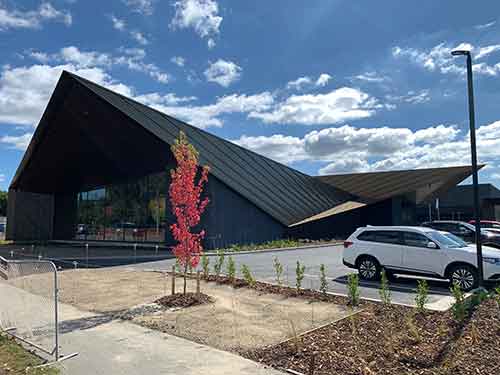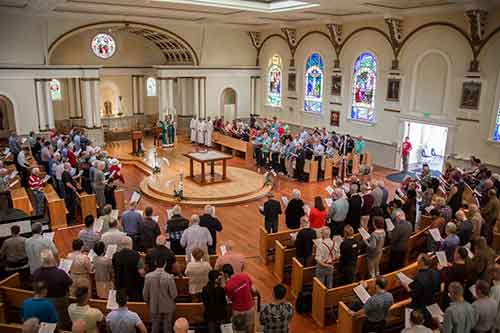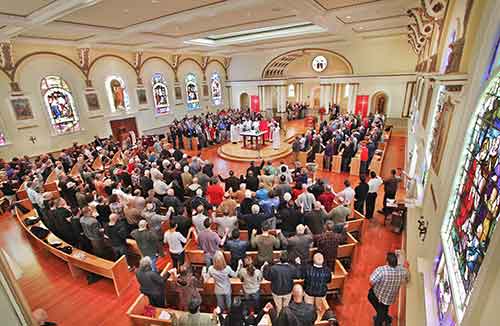
The architects for the new Catholic Cathedral complex in Christchurch have recently been announced. I wish them all the best for an inspiring building, and look forward to what is offered.
Sir Winston Churchill said it well: “We shape our buildings; thereafter they shape us.”
I read about a Roman Catholic parish church that gutted the inside of their worship space, placed a new altar and sanctuary in the middle of the space, and seated everyone around this central, square altar. They did not change the words of the service – they changed the experience of worship by changing the layout.
I have seen worship spaces with flexible chairs which change the layout with the Seasons of the Church Year:
- in the round, around a central altar for Easter and Christmas,
- in “traditional” rows (like on a bus) all facing the same direction towards the altar for Lent;
- facing each other in two straight lines (traditional monastic choir formation) for Ordinary Time before Lent;
- …
The change in layout made a significant change in how the different Seasons were experienced.

Early changes to the authorised Anglican eucharist were not to the text but to the way that the service was “choreographed”. As well as the priest facing the congregation, the introduction, for example, of an offertory procession was part of connecting the congregation more with the presider “up the front”.

Very often I see the Guru’s Cat principle in practice. If anyone dares to ask, “Why do we do this?” – Because that’s how we’ve always done it! People have not thought through to first principles. They like to have a modern building, but there is little thought to why things were done the way they were, and how that “why” translates into our new context.
It is understandable that when priests started to stand “behind” the altar table facing the congregation that the inherited sideboard-style altar was simply pulled away from the wall. The priest, in that make-do situation (of trying to use a medieval-style space for contemporary, post-Vatican II worship) can look like serving at a bar with a garage sale of silver or a prize-giving of cups.
But I have seen brand new Anglican churches (designed after Vatican II) with brand new altars simply continue the inherited sideboard/bar-style altar, about two and a half metres in length, and 0.7-0.8 metres deep. Some, for their new altar, simply replicate the previous size so that Mrs X’s lovely, ancient, wearing-thin frontal can continue to be used without adaptation,…
Burse and veil may have had some aesthetic point when the priest had his back to the people and you could clutter the altar with flowers, candles, a cross, etc. without it being obstructive or irritating. Now, as we gather around the altar, the continued use of burse and veil on the altar, with arcane, esoteric rituals involving them, is simply obfuscating, arcane clericalism.
Plenty of other similar examples spring to mind…
Anglicans in Aotearoa/New Zealand have put a wonderful amount of energy into our agreed verbal texts. But the study, training, and formation in liturgy beyond that is negligible to counterproductive. How liturgical space works, how gesture, vesture, movement, and so forth impact the reality of worship (possibly far more than getting the text just right) does not really get in an appearance.
A good starting point for reflection is my book, Celebrating Eucharist.
After that, do spend time with some of the following posts:
- The community – church architecture 1
- The cross – church architecture 2
- The altar – church architecture 3
- The font – church architecture 4
- The ambo/lectern – church architecture 5
- The presider’s chair and the cathedra – church architecture 6
- Church facing East – Architectural Design Guidelines 1
- Why churches face East – Architectural Design Guidelines 2
- The altar in architectural design – Architectural Design Guidelines 3
- The baptism font in architectural design – Architectural Design Guidelines 4
First three images: my photos of Richmond Club
.





Father B, no matter where you place the table, whether up the front or in the middle, won’t it always be a bit of a bartender serving up drinks? The presider will always be on one side or another, regardless of the shape and size of the table.
Perhaps, David – but I’m not sure, for example, that being on the side of a table necessarily leads to the bartender feeling. I think, for example of St Gregory of Nyssa, The Episcopal Church, San Francisco. Blessings.